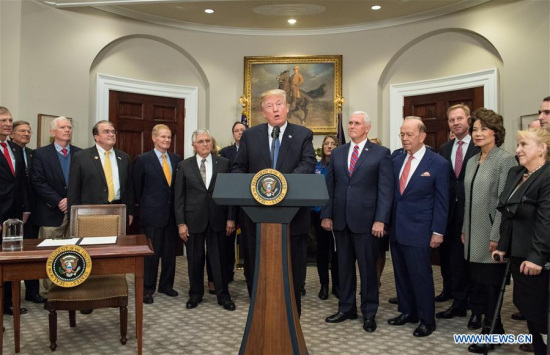 Photo released by NASA on Dec. 11, 2017 shows U.S. President Donald Trump (C) speaking before signing the Space Policy Directive 1 at the White House in Washington D.C., the United States. (Xinhua/NASA/Aubrey Gemignani) U.S. President Donald Trump on Monday signed his administration's first space policy directive, formally directing the U.S. space agency NASA to send astronauts back to the moon and eventually Mars. "This time, we will not only plant our flag and leave our footprint," Trump said at a White House ceremony. "We will establish a foundation for an eventual mission to Mars, and perhaps, someday, to many worlds beyond," he said. Trump offered no specific timeline during his four-minute speech. The Space Policy Directive 1, as it's called, was based on recommendations of the National Space Council, which Trump directed to reestablish in June to advise and help implement his space policy with exploration as a national priority. The council was first created in 1989 during the administration of President George H.W. Bush but later disbanded in 1993 under President Bill Clinton. It marked a return to the vision of President George W. Bush, whose Constellation program aimed to return astronauts to the moon by 2020 and then go on to Mars. However, Constellation was cancelled in 2010 by then-President Barack Obama, on the grounds that Americans "have been there before" and that "there's a lot more of space to explore." Instead, Obama said the United States should start by sending astronauts to an asteroid, a controversial plan known as Asteroid Redirect Mission, which was scrapped earlier this year by the Trump administration. "Since the beginning of his administration, President Trump has taken steps to refocus NASA on its core mission of space exploration," Deputy White House Press Secretary Hogan Gidley said in a statement earlier Monday. "He will change our nation's human spaceflight policy to help America become the driving force for the space industry, gain new knowledge from the cosmos, and spur incredible technology," Gidley said. Both Trump and Vice President Mike Pence, who chairs the National Space Council, have repeatedly expressed interest in human lunar missions during the past year. Pence, during the first meeting of the National Space Council in October, said the moon will be "a stepping-stone, a training ground, a venue to strengthen our commercial and international partnerships." On Monday, Pence said signing this space policy directive will allow America to "lead in space once again" although Trump said "we are (already) the leader and we're going to stay the leader." Monday's ceremony coincided with the 45th anniversary of the Apollo 17 mission, the last time humans walked on the moon. The last living astronaut of the Apollo 17 mission, Harrison "Jack" Schmitt, was also at the event at the White House. When speaking of the moment Schmitt landed on the lunar surface on Dec. 11 of 1972, Trump turned around and shook hands with him, saying: "today, we pledge that he will not be the last." Then, Trump asked: "I suspect we'll be finding other places to land in addition to the moon. What do you think, Jack?" "Yes, we should. Learn from the moon," Schmitt replied. |
Powered by Discuz! X3.4
© 2001-2013 Comsenz Inc.